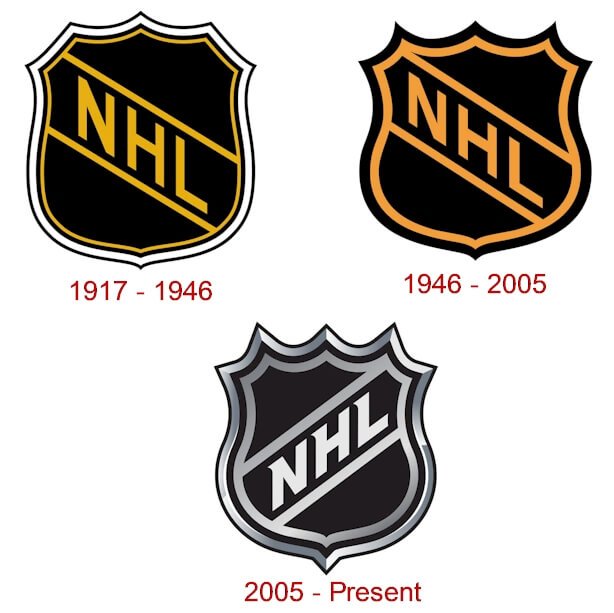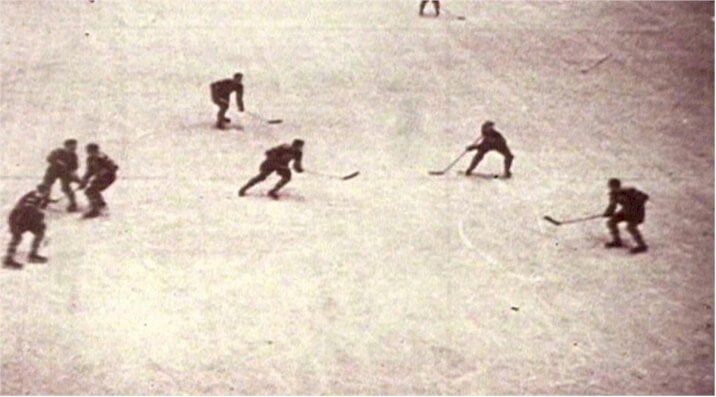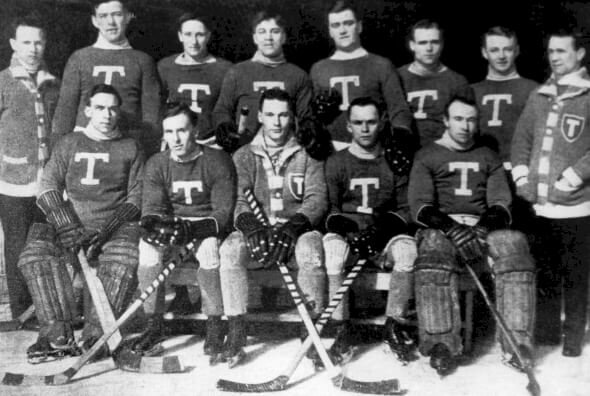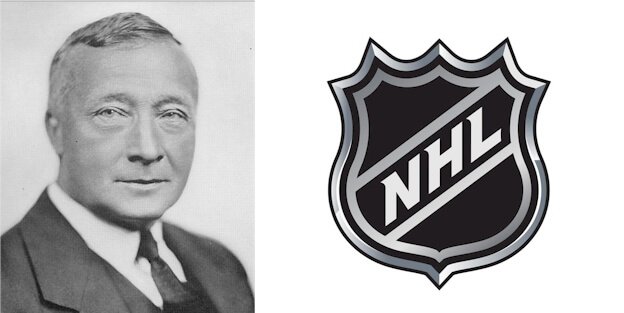The history of the NHL logo is quite long, dating back to 1917 or even earlier. In the incredible history of the NHL, many current and past teams have used primary and alternate wordmark NHL logos.
The famous shield logo of the NHL was unveiled in 1917. It featured the shape of a shield drawn in black and orange.
The present NHL logo was introduced in 2005 and closely resembled the previous version—at least the shield shape stayed the same. But a black-and-white color scheme with a touch of silver-gray replaced the previous black-and-brown.
Another more notable tweak is the manner in which the diagonal wordmark is placed—it faces upward now instead of downward. The font has also been tweaked a bit.
History and Evolution of the NHL Logo

The National Hockey League’s visual identity has remained very consistent throughout the history of the league. First designed in 1917, it has only been modified three times throughout its history, showing NHL’s strength and seriousness.
1917 — 1946
The NHL logo was originally designed in 1917 and had a sleek black shield with a yellow, black, and white outline as well as a yellow wordmark, placed diagonally against a black background and framed in a pair of parallel yellow lines.
The wordmark starts from the left upper corner to the right bottom one and is capitalized and rendered in a basic but solid sans-serif font with straight lines, depicting a sense of stability and seriousness.
1946 — 2005
The NHL logo was first redesigned in 1946, changing the shield’s shape. The shield was made shorter and wider, and the white outline was removed, leaving only the thick black and yellow lines in the symbol.
The yellow became darker, nearly turning orange, while the contrast between the color and the black background got smoother. This still made the badge appear more confident and professional. As for the wordmark, the font was adjusted to a bolder and longer one, making the logo look more balanced.
2005 —Present
With the rebranding of the NHL in 2005, the visual identity was also altered, and there were very noticeable modifications to the logo for the first time. A silver-gray shade replaced the dark yellow hue, making the entire logo look powerful and sleek.
The font of the wordmark was changed to an elegant and sharp one, with the upper areas of the letters elongated slightly and placed to the left. The direction of the wordmark was also changed—it now started from the left bottom corner to the right upper one, signifying growth and progress.
In addition, the border of the frame features gradient shades and appears glossy and voluminous, adding a stylish and modern touch to the national hockey league logo and making it appear powerful and masculine.
The NHL Logo Design Elements

Symbol: The original NHL logo had the shape of a shield drawn in black and orange. The current national hockey league logo, designed in 2005, closely resembles the second version of 1946 to 2005, but the black and brown color palette was ditched in favor of a black and white one with a hint of silver-gray.
The diagonally placed wordmark was also noticeably changed. It now went upward instead of downward. The font was also slightly adjusted.

Color: The present NHL visual identity is monochromatic as it uses black and white only. Apart from that, silvery shades of gray are in the symbol due to the gradient effect.
Font: The custom font used for the NHL wordmark isn’t a sans serif or serif one. Every letter has just one serif, and the other parts of the letters don’t feature serifs.
The History of the NHL (National Hockey League)
The NHL is a topflight ice hockey league for men. Widely considered the number one hockey league in the world, it was founded in 1917 in Montreal, Quebec, Canada. Currently, the league boasts 32 franchises: 25 in the U.S. and 7 in Canada.
The Canadian teams in the league include Montreal Canadiens, Ottawa Senators, Toronto Maple Leafs, Edmonton Oilers, Winnipeg Jets, Vancouver Canucks, and Calgary Flames. Every year, all the teams vie for the Stanley Cup, which is North America’s oldest professional sports title.
Early History (1917-1941)

The NHL was founded on November 26th 1917 in Montreal, Quebec, Canada, succeeding the NHA (National Hockey Association), which had gone under due to a squabble between Toronto Blueshirts owner Eddie Livingstone and the proprietors of the league’s other teams.
The founding members of the NHL included Montreal Wanderers, Montreal Canadiens, Toronto Arenas (predecessor to Toronto Maple Leafs), and Ottawa Senators. Quebec City had a franchise but opted against participating in that inaugural season. That same season, the NHL teams competed with teams from other professional hockey leagues for the coveted Stanley Cup.
The NHL went through many changes in composition, play-off format, and scheduling in the next quarter of a century. In 1924, Boston Bruins was the first U.S. team to join the NHL, and within two years, six out of the ten sides were from the U.S. The 1920s were dominated by Ottawa Senators, which won 6 league championships and 4 Stanley Cups. Sadly, the team ceased to exist in 1934.
Exceptional players of the period include Charlie Conacher, Frank “King” Clancy, Lester Patrick, Aurele Joliat, Nels Stewart, and Bill Cook. The flashiest player was Howie Morenz, while the best defenseman was Eddie Shore.
The Original 6 (1942-1967)

In 1967, the NHL only had six teams still standing: Toronto Maple Leafs, Montreal Canadiens, Chicago Black Hawks, Boston Bruins, New York Rangers, and Detroit Red Wings. The league stayed unchanged in this format for 25 years. Once six expansion sides were brought to the league in 1967, the former six franchises were popularly called the “Original Six.”
The dominant side of the 1940s was Toronto Maple Leafs, headed by Max Bentley, Ted Kennedy, Syl Apps, and Walter “Turk” Broda. They won the Stanley Cup on six different occasions within ten years. But the most outstanding offensive player of the era was Maurice “Rocket” Richard, who scored 50 goals in as many games for Montreal Canadiens in the 1944-45 campaign, including five goals and three assists in a single game.
In 1948, Larry Kwong broke the color barrier by making an appearance for New York Rangers. A decade later, Willie O’Ree became the first African-American player to appear in the NHL when he played for Boston Bruins.
The early 1950s were dominated by Detroit Red Wings, headed by Gordie Howe, Tend Lindsay, Terry Sawchuck, and Red Kelly. In the mid-1950s, Montreal Canadiens put together arguably the strongest team in the history of NHL, which included the likes of Henri Richard, Jean Beliveau, Bernie Geoffrion, Dickie Moore, Dougie Harvey, Jacques Plante, and many others. The team won 6 Stanley Cups, including an NHL record five in succession (1955-56 to 1959-60).
In the 1960-61 season, Chicago Black Hawks ushered in the decade with their first Stanley Cup in 23 years, led by the outstandingly brilliant Glen Hall, Stan Mikita, and Bobby Hull. Toronto Maple Leafs won a further four Stanley Cups, and Montreal Canadiens won two more Stanley Cups before the expansion of the league in 1967.
Change and Expansion of NHL (1967-90)
Six new United States-based teams joined the NHL in 1967: Los Angeles Kings, California Seals (Oakland Seals later on), Philadelphia Flyers, Minnesota North Stars, St Louis Blues, and Pittsburgh Penguins. In 1970, Vancouver Canucks joined alongside Buffalo Sabres, and New York Islanders and Atlanta Flames joined two years later.
In 1974, Washington Capitals and Kansas City Scouts also joined the NHL, bringing the number of teams to 18, of which just three were from Canada. Montreal Canadiens ruled the roost at the time, winning 8 NHL titles from 1967 to 1979.
The NHL merged with WHA (World Hockey Association) in 1979 and expanded again in the process. The WHA had broken the NHL’s stranglehold on professional hockey upon its founding in 1971. In the first WHA season, there were numerous former NHL players in the league, including stars like Bernie Parent, Bobby Hull, Brian Conacher, and John McKenzie. The following season, hockey great Gordie Howe joined his sons Mark and Marty in Houston.
The WHA was initially made of 12 teams, which rose to 14 before dwindling crowds and escalating expenses reduced the league to 7 teams in the 1978-79 season. The WHA folded in 1979 when it merged with the NHL. Harford Whalers, Quebec Nordiques, Edmonton Oilers, and Winnipeg Jets were taken in by the NHL.
The number of Canadian NHL teams rose to 7 in 1980 when Atlanta Flames relocated to Calgary. In the 1983-84 season, Edmonton Oilers became the first former WHA team to clinch the Stanley Cup, bringing four years of dominance by New York Islanders to an end.
The free-scoring Oilers, led by stars like Wayne Gretzky and Mark Messier, won the trophy in four of the subsequent six seasons. The dominant team in the early 1990s was Pittsburgh Penguins, which won two successive Stanley Cups in the 1990-91 and 1991-92 season, as well as a record 17 straight games in 1992-93. The record hasn’t been broken since.
Ice hockey increasingly encouraged offensive play and scoring. In the 1970s, Boston Bruins’ Phil Esposito posted new records for points (152) and goals (76) in the 1970-71 season, while defenseman Bobby Orr reinvented his role, becoming the first defensive player to score the most goals in the league in 1970 as well as in 1975.
The emphasis on offense in ice hockey was epitomized by the incredible scoring achievements of Wayne Gretzky and Mario Lemieux in the 1980s. In particular, Wayne Gretzky’s scoring feats are perhaps unparalleled in any sport. With 2,857 points, he’s the number one scorer in the history of the NHL and the only one to hit 2,000 career points. What’s more, he shares or holds 61 records in the NHL, including most goals and assists—894 and 1963, respectively.
Change and Expansion of NHL Since 1990
In 1991 and 1992, the NHL expanded further, increasing the number of teams to 26. Another Canadian franchise, Ottawa Senators, joined the league. In addition, franchises were awarded to Florida Panthers (Miami), Sharks (San Jose), Mighty Ducks (Anaheim), and Lighting (Tampa Bay).
In 1995, Quebec Nordiques were struggling financially due to playing in the smallest market in the league. They were sold the same year and moved to Denver, in which they were known as the Avalanche. The following year, Winnipeg Jets also relocated after being bought by a Phoenix consortium. They became known as Phoenix Coyotes (later Arizona Coyotes), and this left Canada with only six franchises.
In summer 1997, the NHL announced plans to expand to a further four U.S. cities. By 2000, with the inclusion of Nashville Predators in 1998, Atlanta Thrashers in 1999, as well as Columbus Blue Jackets and Minnesota Wild in 2000, the league had grown to 30 teams.
Atlanta Thrashers moved to Winnipeg in 2011, and the name Winnipeg Jets was restored. In 2016, the NHL stated that a new Las Vegas franchise, Vegas Golden Knights, would join the NHL ahead of the 2017-18 campaign, bringing the number of teams in the league to 31.
Summing Up the History of NHL
The NHL (National Hockey League) is a North American professional ice hockey league, currently made up of 32 teams: 7 in Canada and 25 in the U.S. The NHL is arguably the world’s best hockey league and one of the leading sports leagues in both Canada and the United States. At the close of each season, the Stanley Cup, North America’s oldest sports trophy, is awarded every year to the NHL playoffs champion.
The NHL first branched out into the U.S. in 1924 when Boston Bruins was founded. By 1926, the league consisted of 10 teams in the Northern U.S., Great Lakes region, and Ontario, Quebec.
Between 1942 and 1967, the NHL had just six teams, collectively referred to as the “Original Six.” In 1967, the NHL expanded to include six new teams. The league then expanded again in 1974 and 1979, increasing its teams to 18 and 21, respectively. From 1991 to 2000, the NHL expanded further to include 30 teams. As of 2021, the league had 32 teams.
In terms of revenue, the NHL is the 5th richest professional sports league on the planet, after NFL (National Football League), MLB (Major League Baseball), NBA (National Basketball Association), and EPL (English Premier League).







